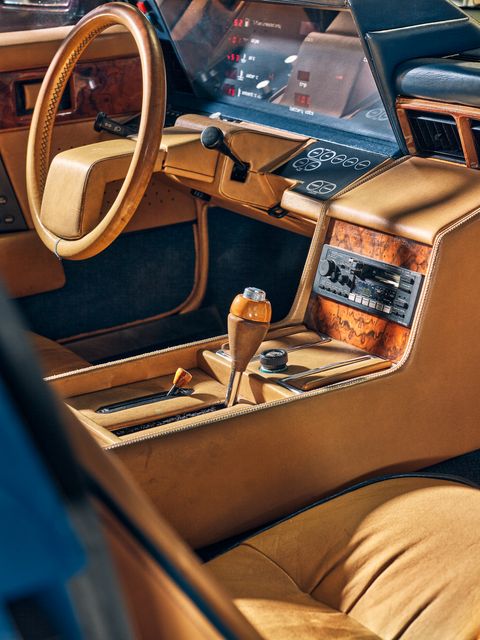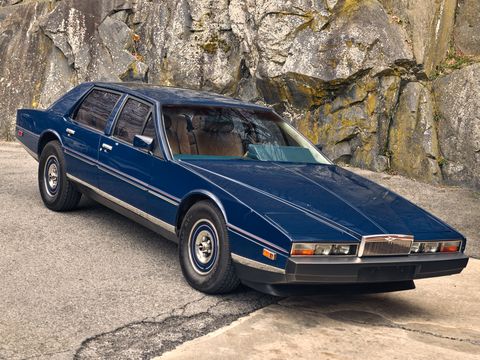Matt Figliola is trying to sort the electronics on an Aston Martin Lagonda. This is no small challenge. The Lagonda, an outrageous four-door wedge of hubristically ambitious Seventies futurism, was the first car with a purely digital dashboard, a technological overreach that nearly bankrupted the company. The one he’s working on lacks the dreaded cathode-ray tube dash, and instead has the dreaded red LED matrix dash and an expansive smattering of disastrous touch-sensitive controls strewn around the cabin. “It’s all malfunctioning and will need rebuilding,” Figliola says. “And we will do some updating to the stereo for sure. This client almost always installs vintage McIntosh Car Audio in his cars. We have a small inventory that we service and keep for him.”
This story originally appeared in Volume 3 of Road & Track.
SIGN UP FOR THE TRACK CLUB BY R&T FOR MORE EXCLUSIVE STORIES
Figliola is accustomed to disasters. He’s been working on solving complex automotive audio and electronic puzzles for decades, ever since he helped a high-school friend install speakers in his Pontiac Sunbird so they could better appreciate the wizardry of Rush and Styx on cassette. (“I liked disco, too,” he adds.) He opened his shop, Ai Design, in suburban Westchester County, just north of New York City, nearly 30 years ago and has become one of the most gifted and well-reputed craftsmen in the aftermarket custom audio space, integrating five- and six-figure custom audio systems in new and vintage vehicles. Cars in his shop right now include a McLaren 720S, Nissan GT-R, Porsche 959, Chevrolet Chevelle, Audi RS4, and Toyota Land Cruiser.
Car audio is big business, and it’s growing in importance for automakers. “We’re seeing data from third-party research like Nielsen, and a certain demographic of people 18 to 24 are actually listening to music in their cars more than anywhere else,” says Jonathan Pierce, senior research and development manager for Harman International, a sound engineering firm that supplies the car industry with stereo systems through a number of different high-end brands, including JBL, Mark Levinson, Infinity, and Harman Kardon. “That trend is growing, with more people choosing the automotive environment as their top location to listen to their favorite music.”
The car is your means of transport, your mobile office, your pandemic sanctuary, and your personal avatar. It’s also your living room tower-speaker symphony hall. And Figliola is the Leonard Bernstein of Tuckahoe, New York.
Early in the 2010s, Figliola saw his car audio business crater. “It was pretty dead for a while because the OEMs really took back the market,” he says. Carmakers began implementing quality brand-name systems. But it has picked up again recently, for a variety of reasons. Algorithm-powered smartphone apps have created an easy-to-use, personalized platform that expands interest. Streaming—accompanied by higher quality Wi-Fi and enhanced cellular bandwidth—now allows near-universal access to a boundless and better-sounding library than the compressed MP3 files of yore. Finally, consumers have gotten savvier and wealthier. They want more.
“The digital-native generation got older where they’re working and they can afford things,” says Figliola. “And the idea of high-resolution streaming music has been out there for a few years, and it seems to be becoming a buzzword today.” He adds that demand will increase further once 5G is more universally available and high-resolution Bluetooth audio is adopted.
Of course, hearing this quality output requires that you have a system that can properly process the input. “If you have a brand-new Porsche, for example, and you want to bring your high-res music into that car, it’s not going to translate that way out the other end,” Figliola says. “It’s going to get knocked down because the stereo is not actually capable of playing something at that resolution.”
In order to create a system that can transmit this superior quality sound, and in order to properly tune the system for optimal in-car playback, Figliola and his team must do a few things. Carmakers add their own proprietarily tuned digital signal processors (DSP) to the mix. Figliola attacks this first, either bypassing it or modulating it so that he can control the virgin signal. “What we’re trying to do is to remove the imposed equalization that the manufacturer puts in the car,” Figliola says. “I call all of that ‘the front end.’”
The hardware portion—speakers and amplifiers and cable—are, thus, the back end. “That’s really where the magic is, and that’s where you can influence things the most,” Figliola says.
His general approach here is “to put as much speaker as I can into front positions, the doors and dash.” Key to this strategy is optimizing the placement, something Figliola says OEMs can struggle with. “They put tweeters into the crotch of the windshield-dash area, and then they’ll put a grille over that speaker that’s not terribly transparent audio-wise,” he says. “When they do that, they just put the most directional speaker in the worst position.” (Pierce notes that components used by automakers must meet strict industry safety and longevity standards to which the aftermarket is not bound. “We have to make sure those speakers are going to last for ten years,” he says.)
Figliola will instead install tweeters in areas that will provide “more access to the listener and a more unfettered location,” meaning upright, exposed, and facing the occupants. This helps with the directionality and locatability of higher-frequency sound. He’ll then prioritize the installation of a really strong mid-bass woofer, typically in the front door, which helps pull low-frequency output forward from the subwoofer that he’ll mount in the rear. This makes “the attack of the sound” much more precise and helps to diminish decay, degradation, and what he calls “listener fatigue.”
The tuning of each of these individual speakers for an ideal sound—performed by Figliola and his team with a laptop, a good ear, and countless hours of tweaking—is a large part of what separates his systems from stock. “We use a full parametric equalizer, which allows us to assign whatever crossover point to whatever speaker we like, assign whatever gain on any amplifier channel. We can even mess around with nerdier aspects like changing the phase of any speaker or the type of crossover,” Figliola says.
The other hallmark of Figliola’s shop is the integration of these components. They use high-quality and resonant Baltic birch for building custom housings, and stiffen the housings against rattles (which degrade sound reproduction) via ABS plastic, aluminum, or even steel reinforcements. They apply dampening materials to keep the sound waves flowing in the proper direction. And then, using computer-aided design systems, three-dimensional printers, and a team of wood, metal, fabric, plastic, and leather fabricators, they design, produce, prep, paint, and trim the components to match whatever part of the car they’re going to be attached to. “The end result is something that does look different than stock, but it looks like the OEM might have done it,” Figliola says.
Just as the inclusion of subwoofers in OEM systems was a trend that emerged first in the custom aftermarket world, quality integration is the next area that automakers and audio suppliers are keeping an eye on. “The installation, the industrial design, the integrity of the components. That’s something that we might be chasing and that they have the advantage on,” Pierce says. This factor has become so important, in recent sound-system competitions, the single category “sound quality and installation” has been split in two, scored separately.
For Figliola’s shop, achieving a quality install can mean going to crazy extremes, such as building custom speaker enclosures for a Fifties Bentley out of book-matched wood veneer, thatched cane, and piano black. Or creating customized and laser-etched switches for the dash of a 1969 Camaro SS, complete with a project-specific vintage-inspired font. Or fabricating a removable, Bluetooth-enabled speaker with a retro guitar-amp grille for a 1967 Cobra. Or resto-modding the tiny graphic equalizers that came in Toyotas, Nissans, and Mitsubishis in the Eighties and Nineties to work with contemporary components.
By all accounts, the future seems loud for in-car audio. “I think we’re going to see a lot more features. Not just on the music side. But also audio for safety. Road noise cancellation. How navigation prompts come to you,” says Pierce. “And looking toward the future with autonomous cars, the car becomes your living room, and you definitely want that audio upgrade experience.”
As much as Figliola and his shop embrace
the future, staying current with the needs of autophillic audiophiles, he recognizes that there is something deeper and more elemental in the connection between cars and sound. That our vehicles are not just a delivery device for audio, but active participants in the listening experience, and vice versa. Figliola takes us back to that Lagonda, the otherworldly growl of its quad-carbureted V-8 engine on startup, and the way that is forever connected to the crazy way the car looks and feels, what sets it out of time.
“The first time I saw one was at the supermarket I worked at when I was 15,” he says. “A lady stepped out of one. For years, I had no clue what it was. I thought it was a spaceship.” He wasn’t wrong. Old cars are time machines, and the sounds they make, inside and out, carry us back to the past, and forward into the future.
SIGN UP FOR THE TRACK CLUB BY R&T FOR MORE EXCLUSIVE STORIES
"sound" - Google News
March 13, 2021 at 04:30AM
https://ift.tt/3cnWieY
The Stealthy Art of Ultra-Custom Car Sound Systems Road & Track - RoadandTrack.com
"sound" - Google News
https://ift.tt/2MmdHZm
Shoes Man Tutorial
Pos News Update
Meme Update
Korean Entertainment News
Japan News Update




No comments:
Post a Comment